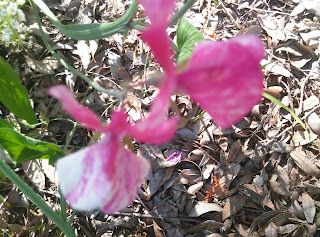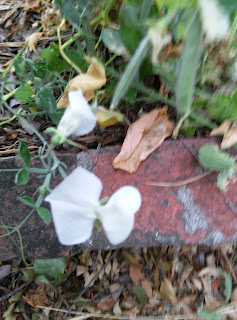Spring 2012 also brought us a good showing of California poppies. After years of planting seeds to no avail, we had bought two small pots (one the standard orange-gold and one 'mixed') at the Theodore Payne Foundation.
In spite of coming from different states, the Texas sun drops and California poppies looked very much alike -- small flowers with four rounded petals on feathery foliage. We enjoyed their simultaneous bloom, but then the poppies' lighter gray-green foliage died back while the sun drops' tiny dark green leaves kept their color and continued to produce the occasional bright blossom throughout summer and fall.
This week, with December looming, I noticed two buds on the Texas sun drops and thought they looked like tiny balloons. Not inclined to assume a nose-to-ground posture to study them, I picked the larger one yesterday and brought it inside for closer observation. The top of the sun drop bud, pale yellow cross-crossed by thin red lines like a miniature gift tie, is a square folded in on itself like a cooty catcher or origami box. California poppy buds are cones, tightly wrapped with a pale green cover (pixie hat) that's cast aside when the flower opens.
I suspect the outside of the sun drop bud will fold back to reveal the flower. On its second day of captivity I think I see the bud's diagonal lines getting wider -- turning into cracks so as to pop apart. If the flower opens, I will be standing by to look at it under the magnifying desk lamp. Otherwise, another sun drop bud will have to be picked in the interests of science.
Googling 'Texas sun drop,*' I learn that there are at least six species of Calylophus, which belongs to the Onogracea (evening primrose) family. Wikipedia's larger-than-life photo shows "Calylophus drummondii in the Water Conservation Garden at Cuyamaca College, El Cajon, California, USA." Noting this location for our next trip to the San Diego area, I eagerly pursue more on-line links.
Calylophus drummondianus var. berlandieri, under the common name of 'shrubby primrose,' was University of Arkansas' Plant of Week in June 2008. Due to some confusion between the work of two 19th-century botanists, the Scottish Thomas Drummond and the French Jean Berlandier, shrubby primrose is often attributed only to Drummond, "a plant collector sent out by London’s Kew Gardens to collect plants in Texas," or to Berlandier, "part of the team assigned to survey and establish the Mexican borderline." In fact, however, it should bear the names of both.
I love these stories of taxonomic history, but now of course I wish I knew what these charming yellow flowers were called by pre-Columbian natives on both sides of the border.
What I do know now, to my great satisfaction, is that some people call Calylophus drummondianus var. berlandieri the 'square bud primrose.' A site devoted to native plants of the Texas hill country shows a beautiful photo and waxes eloquent: "A splash of yellow on a low mound of thin grassy foliage makes this plant special. Plant in full sun and enjoy a flush of spring bloom and additional blooms from time to time in the summer." In this mild climate, I expect a few "additional blooms" in December and look forward to a "splash of yellow"along with our California poppies and barrel cactus in March and April.
- - - - - -
* 'Texas sun drop' also comes up as "an exhilarating citrus soda."
P.S. (added November 30) The bud is opening! I was totally wrong about the diagonal lines, which have become the center lines of each sepal. The other crisscross (the red one) is the one that has split apart to reveal bright yellow foliage folded intricately inside. I have seen what I needed to see and will not need to sacrifice another bud from the garden!




